Europe on WHAT! Per Day?
My Actual Travel Expenses, in Tables and Footnotes
Expense summaries for travels in Europe.
Sit down. Paris on $451.43 per day in 2008, all in. It is time to return to my budget chapter and figure out a way to save money. But US State Department suits and corporate cogs will laugh at these figures. Their expense reports will come in five times higher. College students and retirees will choke. Most Europeans will say that these numbers are pretty close to what it reasonably costs to take a break in Paris.
More recently I spent five weeks of the summer of 2015 in Haarlem, Netherlands for much less. I used my frequent flyer miles, stayed at the B&B Paula (which is actually a fully furnished apartment), and ate mostly at "home." I made train excursions to Amsterdam and Leiden, and biked all around Haarlem, to Zandvoort aan Zee, and the petite villages west of Haarlem. It was the best trip of my life.
Carpe diem. Vivere bene! Gratia Deo.
Chapter 2 Part 2 of
HOW TO EUROPE:
The Complete Travelers Handbook
John Bermont
This entire book is published totally free on-line by the author and photographer, yours truly, with help from my daughter Stephanie. Yes, you can copy — if you ask first. Please read my copyright and permissions statements. Visit my home page at enjoy-europe for truck loads of more helpful illustrated travel information sans pareil. If you have questions or comments after reading this chapter please see NOTE TO READERS. Updated 1 November 2015.
The reckoning.
This Internet edition of chapter 2 is divided into two parts:
EXPENSE vs BUDGET
A budget is the amount you plan to spend. An expense is the amount you actually spent.
Part 1 of this chapter provided a workbook for making your travel budget. That is all the theory. Now let's get down to business. Show me the green.
In this Part 2 I present tables and explanations of my actual expenses for some of my travels in Europe. When on the road I keep a detailed travel log book. See chapter 9, Your Travel Diary of Europe: Blog It. I keep all my receipts. Sometimes I must ask for a receipt and sometimes I must write the date and amount on it because the merchant's equipment didn't do a legible job. On the plane homeward bound I put it all together in a spreadsheet, as described in Part 1 of this chapter.
I have included my spreadsheet summaries for two trips in this chapter to give you an idea of what it really costs to travel in Europe. These are from 2006 and 2008, not too long ago. The fact is that a major cost parameter is the exchange rate of the US$ versus European currencies. Except for Switzerland the dollar has been doing better against European currencies so these cost figures are not out of line for 2015. My own trip for five weeks in the summer of 2015 is so unusual that the cost data is meaningless for vacation travelers.
For historical perspective, or amusement, the appendix below shows what my travels cost back in the "good old days" of the 1980s. I never had a $5 day in my travels. But thanks anyway Arthur Frommer. Your book was my Sacagawea and served me well. However I am still amused that on page 2 you say that the price on the cover is for "accommodation and meals only" (emphasis yours). Reviews of Europe on $XX per day and many others are at Guide Books and Maps: Tomes for Europe Travel.
COSTS FOR TWO TYPICAL TRIPS
I've selected two more or less representative trips I've made in the recent past to show what it actually costs to travel in Europe, at least for me. It can be done for less but I consider this to be spartan enough.
Britain and Ireland, April and May 2009
Weather-wise, spring is the most pleasant time to travel in Europe. The grass is green and the blooms are out. There are few travelers because most schools are still in session, so getting an economical room is relatively easy. Still, nothing is really cheap.
My trip included 6 days in London and 2 days each in Cardiff, Cork, Dublin, Belfast, Glasgow, Edinburgh, and York. I also had an overnight in-transit stay in Wexford, Ireland. My cost analysis for this trip is presented in Table 2.1. The British pound was worth $1.47 to $1.50 during this time. The euro, used in Ireland, was worth about $1.30.
Table 2.1.
| Travel Cost Analysis, Britain and Ireland | |||
|---|---|---|---|
| Item | Daily Cost Average |
Total Cost 21 Days |
Foot Notes |
| Room | $53.51 | $1,123.73 | 1. |
| Food | $43.12 | $905.51 | 2. |
| Transportation, air | $23.75 | $498.77 | 3. |
| Transportation, ground | $50.45 | $1,059.54 | 4. |
| Thirty Miscellaneous Items | $50.74 | $1,065.67 | 5. |
| TOTAL | $221.58 | $4,653.12 | 6. |
FOOT NOTES to Table 2.1:
1.) My economy rooms in London were a 2 star hotel near Paddington Station for my first and last nights. I also stayed at the Rosebery Hall dormitory of the London School of Economics for four nights. The LSE Rosebery Hall is a really good deal, especially for London. In Ireland and the other British cities I stayed in B&Bs (bed & breakfasts) most nights. I traveled without reservations, finding rooms on my own or with the aid of city tourist offices. In the USA B&Bs are typically over-priced elite cult establishments. Some are priced up there with the Royal Suites at Hilton hotels. In Europe B&Bs are reasonably priced and the breakfasts are really filling — eggs, potatoes, sausages, tomatoes, and coffee/tea/chocolate plus juice and/or fruit. I did one night in a 3 star hotel in Wexford, Ireland. Hotels are much cheaper in those smaller cities.
2.) When in London the best meal deals are in pubs. Pubs are ubiquitus. Menus are posted outside so you know what is available and at what cost. Typically you order at the bar and then find a seat, if possible. Shortly a bar man will bring your plate and your brew. I'll never order fish and chips again in this life. In the smaller cities I would usually eat at a small restaurant. I had some great fish chowder in Dublin. I would sometimes go to an upscale hotel for a fine meal at lunch. The quality is good and the price is not nearly what it would cost to have dinner in one of those places in the evening.
3.) My air ticket was a steal. I shopped a long time to find this. I flew Delta from MBS via DTW and AMS (Amsterdam) to LHR (London Heathrow). Returning I went from LHR to AMS, then to MSP (Minneapolis) and home to MBS. I could have left out AMS and MSP but the more direct flights were significantly more expensive. An extra kicker is that I score more frequent flyer miles with indirect flights. Note that the "daily" cost of air transportation is the ticket price divided by 21 days.
4.) Ground transportation included airport buses and the London Oyster Card for unlimited bus transport. I should have bought the Oyster Card which included the Underground, known as The Tube. Individual Tube tickets are bloody expensive. I also used a BritRail FlexiPass which allowed me eight days of travel on British rails. Further costs included tickets on the ferries between Britain and Ireland and bus and train tickets in Ireland.
5.) Miscellaneous costs included internet time, museum entries, city sightseeing tours, café stops, books and maps, a camera memory chip, and the usual souvenirs and gifts.
6.) The total cost is fairly reasonable for a three week trip around the Islands. Surely it can be done for less but that would require giving up some creature comforts.
Paris, December 2008
I went to Paris in December 2008 for 4 days. That is 4 days and 4 nights, not counting fly time which is about half a day at each end. My costs are summarized in Table 2-2. Note that the euro at that time was worth $1.27. It has bounced up and down since then. As of November 2015 it is down to about $1.10 so my costs would be 13% less now, plus inflation in France. For background on the euro, an interesting historical chart, and links to currency exchange rate sites see my page at Euro and Other Currencies: Exchange Rates for Travel in Europe.
Table 2.2.
| Travel Cost Analysis. Paris, France. | |||
|---|---|---|---|
| Item | Daily Cost Average |
Total Cost Four Days |
Foot Notes |
| Room | $85.29 | $341.16 | 1. |
| Food | $84.01 | $336.04 | 2. |
| Transportation, air | $179.70 | $718.18 | 3. |
| Transportation, ground | $16.30 | $65.18 | 4. |
| Thirty Miscellaneous Items | $86.29 | $346.16 | 5. |
| TOTAL | $451.43 | $1,805.72 | 6. |
FOOT NOTES to Table 2.2:
1.) I consider myself a frugal traveler. My hotel was a small two star place in the 6th Arrondisement near Gare Montparnasse. It was €61 per night plus €6 for breakfast. I had stayed there many years before in the French franc days when it was about $10 per night. But I knew I was in the right place because the other guests were Europeans, mostly Dutch. Dutch people don't let a penny out of sight.
2.) I could have spent less on food, but heck, I was in Paris! After a couple nights of pretty good dinners, but no Michelin $500 places for sure, I bought some bread, cheese, meat, salad, and wine and made a picnic in my room. There is a very good group of small stores at Place Maubert a few blocks from where I lived in the 1980s. There is also a farmer's market a few times a week.
3.) There is no way around paying for a plane ticket, except to use frequent flyer miles. I could have done that but I am saving them up for a major spring-summer trip. The cost of air tickets is much higher in the summer so the frequent flyer miles will be sweet. I got this fare after diligent searching for weeks. It was round trip from MBS (Midland, Bay City, Saginaw, Michigan) to CDG (Paris) with a change in DTW (Detroit). Note that the "daily" cost of air transportation is the ticket price divided by 4 days.
4.) The ground transportation cost is mainly getting to and from airports plus a Paris Pass for unlimited use of the Metro and buses. This is a good value compared to the cost of individual trip tickets.
5.) So how the heck can I spend so much on "Thirty Miscellaneous Items?" The answer is that about 2/3 of it was gifts and souvenirs. Most of the rest was in café stops. A coffee or beer can cost €5 to €10 depending on what part of Paris you are in. That was about $6 to $12 when I was there. Ouch. On this trip there were no expenses for museum entries. I've been there and done that. I walk the streets and take in the atmosphere. There is only one Paris. By the way, museum entry in Paris is free for people under 26.
6.) The grand total looks rather formidable for a person of my limited means. I won't be going back to Paris for a few years. Next time I'll spend my France time in the smaller cities where the costs are more reasonable.
COSTS FOR A NON-TYPICAL TRIP
Nearly zero.
Ed Buryn
The genius of low cost travel is someone you have never heard of. His name is Ed Buryn. His book is Vagabonding in Europe and North Africa. Ed has a very open minded approach to life, people, and surroundings. He reminds me of the character Oddball played by Donald Sutherland in Clint Eastwood's movie "Kelly's Heroes." The book is a classic of its times, the 1970s. Unfortunately Europe has grown up and Ed's approach is now history. But he has a great story that every traveler should read.
CUTTING COSTS
Cost data can be divided between variable costs, i.e. so much per day while you are traveling, and fixed costs, i.e. so much per trip to Europe. The fixed cost is your plane fare and associated ground transport. Even this can be variable because the fares for most airlines increase dramatically when you stay for more than 30 days. Rail pass costs increase for longer term passes, but not proportionally. The longer your pass is valid, the lower the per diem cost. This goes for city transport costs also.
As is evident, except for very short trips the variable costs will be more than your fixed costs. You will need to feed and house yourself daily, and you will be subject to additional costs for ground transportation, entertainment, souvenirs, and other items.
The total costs should in truth be reduced by your costs had you stayed home. Variable living costs you have at home will be partially eliminated and that money can be used to partially offset the cost of your European expedition. Call your phone company and see if a "vacation hold" is available. Cancel your newspaper for sure.
To get on a "low" budget, spend most of your time in southern and eastern Europe. If you really want to save money and have an interesting time, go on over to Romania, Bulgaria, Ukraine, Turkey, the Baltics, and other countries in the east. Get there before western economics ruins the bargains.
Hostels (that is hotel with an s in the middle) are a low cost room option. I have used these dormitory type accommodations in a number of cities. See my page at Hostels in Europe.
TIPPING
Some guidebooks have a special section telling you how much to tip the taxi driver, bell captain, porters, waiter, theater ushers, ad infinitum. These advisories are generally designed to waste your money. I've talked with some Dutch waiters who gleefully told me about the extra 20% that American tourists leave on the table.
In spite of that statement I am a strong believer in tipping, and generous tipping, for service workers. Service workers include everybody from restaurant staff to taxi drivers, and even the plumbers who did me over on a new hot water heater.
However, most services for which you pay in Europe already include a 15% service charge. The service charge goes to the person who personally provides the service, or into a kitty to be shared by everyone on the staff. The service charge is the tip, but it is obligatory. Listed prices on menus usually include this service charge, but when they don't, the house always adds it to your bill. You may leave a few coins of the change, round up by 1% to 3%, as a tip. In fact, often such amounts are not even returned when change is due.
Regular Customer
One place where it is especially helpful to tip is in a café or bar. This will help to insure promptness for your subsequent visits, and they will remember your name.
Toilets
In a few cases, most notably washrooms, tips are expected. There is invariably someone in there or at the door who is responsible for keeping it clean. Don't be surprised if you gentlemen notice a woman mopping the floor next to you as you use the urinal.
Toilets almost everywhere, except on the trains, require or request a donation. The usual approach is to have a saucer on a table outside the toilet. Sometimes the requested amount is stated on a hand written sign, and sometimes the toilet attendant is sitting there hovering over the saucer of coins. Donate whatever coin you see in the saucer, equivalent to maybe a dime.
To Tip or Not To Tip
In cases when a service is provided without charge, use your judgment and give what you think is appropriate.
Europeans are accustomed, for example, to tipping the hotel chamber maid, something not done in America. You could leave a few coins on the pillow. In ritzy hotels on the Riviera I have seen places where the hotel price does not include "service" charges so 15% is added to your bill. If you can afford $500 for the room I guess you can afford another $75 for having your bed made.
Another appropriate tippee would be a table-to-table musician or group playing and starving while they watch you eat. They also work on the streets and the Metros and appreciate all the coins you toss in their open guitar cases and hats.
When driving in some countries, kids run out to the cars at stop lights with a wash bottle and rag to do the windshield. Make sure they clean it, not just smear the dirt around.
Keep some small bills and change in your pocket. Do not reach for your wallet for those worthy of a gratuity. In all other cases save your money.
EXPENSE REPORT
You may want to make an expense report, or you may need to do so for various reasons. Let me tell you — it is complicated.
The major complication is the fact that you will be spending money in different currencies, and the value of those currencies is constantly changing. Another potential problem is that some outlays will occur weeks or months before you use the services or acquire the goods.
My approach is to set up a spreadsheet. I use Lotus 123. Most people use Excel because that is what their company IT honcho gave them. Lotus is better than Excel, but this is another example of bad product with forced marketing driving a better product nearly out of business.
Everybody sets up spreadsheets differently so I won't go into the nitty gritty. In general, the things you probably should have categorized are:
- Date and day of the week
- Location
- Category:
- Air transport
- Ground transport
- Room
- Meals
- Gratuities
- Communications
- Business supplies
- Entertainment
- Personal expenses
- Gifts
- Currencies
- Exchange rates
Of course you can't make a notation in your spreadsheet every time you spend a centime, but you can get a receipt for most things. For the others make a notation in your log book or pocket diary. Check the receipts to make sure you can decipher them later. Check the date. Carry an envelope and stuff all the receipts, used bus tickets, and such into the envelope.
On the plane coming home you are going to have 8 to 10 hours of totally dead time. Pull out your envelopes full of receipts and your laptop and get busy on your expense report spreadsheet. The time will fly faster than the plane, and you will have that onerous task behind you when you land. Shock your boss or accountant with your expense report first thing in the morning after you return.
APPENDIX
Historical Cost Data
Back in the days when the title of a famous travel book boasted that the daily cost of travel in Europe was about the price of a couple of hamburgers at home I kept detailed records of my expenses. I only include this material now because of the notes which explain the costs. The costs are out of date, but the notations are still of value. You may want to compare your costs with mine 35 years ago, or with those of a British traveler 80 years ago. I have a book titled "Holland on £10." That was per week, back in 1936.
1980 at $115 per Day
For the three week trip I made in March 1980 through ten countries of northern Europe, I spent an average of $115 per day. The cost analysis is shown in Table 2-3.
Table 2.3.
| 1980 Travel Cost Analysis | ||
|---|---|---|
| Item | Average Daily Cost over 22 Days | Foot Notes |
| Room | $23 | 1. |
| Food | $18 | 2. |
| Transportation | $36 | 3. |
| Thirty Miscellaneous Items | $38 | 4. |
| TOTAL | $115 | 5. |
FOOT NOTES to Table 2.3:
1.) Room costs ranged from $10 to $40 per day for a single room equivalent to a two or three star hotel in France. This average figure of $23 included sleeping "free" one or two nights a week on an overnight train, in a seat, not a bunk. The minimum figure applies to smaller cities, and got me a small single on the fourth floor, no elevator, narrow stairways, no toilet or shower in the room, and maybe a breakfast. But it was clean, warm, and comfortable nine times out of ten. The upper figure, $40, fetched a comfortable, well-plumbed double in a major city.
2.) Food costs ranged from $5 to $50 depending on appetite and location, service and tax included. My $18 average figure included some restaurants and some picnics. A rough estimate of prices in average restaurants can be used to make up your budget. In countries like Germany, with all-you-can-eat breakfasts, I could get by with a light lunch for about $3, and top off the day with dinner at $15 to $25. In countries like France, where breakfast will barely open your eyes, a hearty lunch cost about $7, and a good dinner $12 to $20. These costs included liberal quantities of house wine or beer, and coffee. Soft drinks and bottled water cost about the same as locally fermented products.
3.) The transportation figure is based on a three-week trip consisting of: Laker Airways round trip from Los Angeles to London; a train/boat round trip London to Oostende, Belgium; and a 21-day Eurailpass. Sadly, Laker Airlines Skytrain was forced out of business on the day that the first edition of my book How To Europe: The Complete Travelers Handbook came off the press, February 5, 1982. Freddy Laker was a pioneer in the air transportation industry and saved millions of people billions of bucks over the years. Unfortunately, the pioneers are the ones with the arrows in their backs. Laker fell to the entranched powers. My transportation costs in March 1980 are shown in Table 2.4.
Table 2.4.
| 1980 Transportation Costs | |
|---|---|
| Item | Cost |
| Air Fare (LA/Gatwick/LA on Laker Skytrain) | $438 |
| Train/Boat (Gatwick/Oostende/Gatwick) | $80 |
| Eurailpass (21 days in Western Europe) | $270 |
| TOTAL transportation cost | $788 |
| Averaged over 22 days, cost per day | $36 |
4.) Thirty miscellaneous items averaged out to $38 per day. You may wonder how in the world you can spend that much on miscellaneous items. Somehow, I managed to do it. Look at the list in this chapter again to get some idea of where all that money goes. Back in those days one or two rolls of film a day could eat up pocket money like a paper shredder. Of course I shoot digital now and save loads of money by doing so.
5.) After summing it up, my frugal trip cost me $115 per day way back in 1980. Multiplying this out, my 22 days cost $2,530. That includes everything, so don't compare that to the cost of a guided tour until you crunch the numbers. Do the math, ALL of the math. Tour costs never include everything. And the famous book from Frommer says, on page 2, that transportation is not included in his $5 a day. Let me get this straight. A guy writes a travel book and does not include the cost of transportation in the ridiculous $5. How does one actually do the traveling? Walk?
1983/1984 at $98 per Day
From October 1983 through January 1984, I traveled for ten weeks through fourteen countries and spent slightly less per day than I did in 1980. This was due largely to a stronger dollar and partly to the fact that I spent half of the second trip in the Mediterranean countries where rooms and food can cost one-third as much as in northern Europe. The cost analysis is shown in Table 2.5.
Table 2.5.
| 1983/1984 Travel Cost Analysis | ||
|---|---|---|
| Item | Average Daily Cost over 71 Days | Foot Notes |
| Room | $22.68 | 6. |
| Food | $22.82 | 7. |
| Transportation | $19.40 | 8. |
| Thirty Miscellaneous Items | $33.30 | |
| TOTAL | $98.20 | 9. |
FOOT NOTES to Table 2.5:
6) Hotel prices for a three star single with toilet and tub (or shower) ranged from $35-$50 throughout Scandinavia to $7-$30 in Greece and Iberia. Single rooms ran from $20 to $40 in France, Germany, Ireland, Switzerland, Austria, and Holland. Overall, I stayed in slightly better rooms on this trip than I did in 1980, but thanks to the strong dollar, the average daily cost was almost identical.
7) Dinner prices for the complete stuffing ranged from about $15-$30 in Scandinavia to $5-$20 in Greece and Iberia. The high end prices in Greece included a floor show and live music. I don't think that I ate any better on the 1983/84 trip, but my costs were significantly higher despite the fact that the dollar was worth much more than in 1980 — 50% more in Germany to 100% more in Italy.
8) The transportation figure is based on two one-way flights plus a two month Eurailpass. The breakdown is shown in Table 2.6.
Table 2.6.
| 1983/1984 Transportation Costs | |
|---|---|
| Item | Cost |
| Air Fare (LA to Düsseldorf on LTU) | $373 |
| Air (Amsterdam to Los Angeles on KLM) | $444 |
| Eurailpass (two months) | $560 |
| TOTAL transportation cost | $1,377 |
| Averaged over 71 days, cost per day | $19 |
9) Thus, at $98.20 per day, my 71 day trip cost $6,972.
The importance of eating and sleeping in off-the-trail places can never be over emphasized. Front row center always costs more because you get a better view. But when eating or sleeping what you see is your plate or pillow. So get off the main boulevards for real value. And you will usually have a more interesting time to boot. To help get costs under control in northern Europe, seek out Greek and Italian restaurants. They generally offer the best value for low budget travelers, not to mention that it often tastes better than local fare, especially in Britain but not so in France.
1986 at $36 per Day
My 1986 sortie was for five months and was spent mostly in Paris. I rented a small furnished apartment on the left bank near Metro Maubert Mutualité for about $500 a month. I shopped for groceries at the Place Maubert farmer's market and cooked most of my own meals. Getting over there was a bargain. I flew Los Angeles to Amsterdam for $400 round trip after finding a short-lived special deal. Not only that, KLM bumped me up to business class on both flights at no cost. April is a good month to cross the Atlantic and May is a beautiful month to be in Paris. Amsterdam to and from Paris was on a purchased train ticket. My Paris transportation costs were mainly for metro tickets though I lived close enough to the Alliance Française that I preferred to walk to school, usually taking the short cut through the Jardine Luxembourg. I stayed mainly in the city, with occasional day trips out to nearby villages. Living like this is certainly one of the most economical ways to see Europe, albeit a small part but a very good part. My costs were actually much less than if I had stayed home in Newport Beach.
1990-2000 at a Profit
I spent about half of the 1990s in Europe, but can't give much in the way of cost details that would be relevant for travelers. For over 2 years we lived in Germany. The company I worked for provided a free home, utilities, car, insurance, and maintenance. I had frequent fully paid business trips throughout reunified Germany, eastern Europe, and as far as Singapore. We also enjoyed annual home leaves on the company coin. As mentioned later in the book, taking a company-paid transfer has got to be one of the best ways to see Europe. To see what this is all about see Working in Europe: Get Paid to Travel, Moving to Europe: Things to Know Before You Go, and Living in Europe: Travel to the Max as an Expatriate.
Starting from Aschaffenburg (near Frankfurt a/M), Germany, Elizabeth and I made a one month expedition to Istanbul, Turkey in 1993 using the company car. Traveling through southern and eastern Europe was inexpensive, to say the least. Those who want a low cost vacation, get yourself south and to the former Evil Empire. A trip over there will cost about 1/3 of what you will spend in Germany and France.
A one-month Eurailpass journey in 1997 was also very low on cash expenditures. For that month, traveling alone I stayed mainly with family and friends in Italy, Austria, Germany, France, and Holland. I used hotels for only five days that May, in Biarritz and Aix-en-Provence where I was one of the few early season visitors. You'll have a hard time finding a room in these cities in July unless you book early. Make sure you read chapter 14, Hotels, Hostels, B&Bs, and Private Homes: Sleep Options for Travel in Europe, to learn how to get a discount every night in European hotels.
One of the ridiculous ways I wasted money, time, and calm nerves was to rent a car in Amsterdam and make a round trip to Milan to pick up Stephanie in July 1998. I got caught in the vacation-bound herd going south through France, got utterly lost in Switzerland on top of a 9,000 foot mountain on Saturday night at 2:00 am, and lost myself twice again trying to get out of Milan and then around Antwerp. I spent about $1,000 renting a midget of a vehicle, filling it with gas too often, and paying highway and tunnel tolls, meals on the road, and a hotel on the way back north. I could have flown Stephanie to Amsterdam first class for less than that.
2002-2003
My three week trip to The Netherlands and Belgium in December and January was a particularly low cost venture. I used frequent flyer miles for my air ticket and stayed with Paula in Haarlem B&B Paula. I looked in on 5 of the hotels in Haarlem to see about room rates. The lowest cost, even of those mentioned in the budget guide books, was about $60 per night for a single with toilet and shower. The low cost rooms measured about 6 feet by 9 feet and had a single bed. Dinner cost $40 for the two of us at our favorite budget restaurant, including a bottle of wine and a couple shots of jenever, that tasy Dutch gin. The average price of a 33 cl (11 oz) beer was $2. Round trip train tickets to Amsterdam cost $6 and a round trip "Super Day Return" train to Brussels cost about $35. My major expense category was film and processing, partial results of which you see throughout the book in your hands. I use a digital camera now. It is a huge money saver for a shutterbug like me. See Photography in Europe: Travel with your Camera.
Have a good trip!
NOTE TO READERS
I welcome questions, comments, complaints, and compliments. If you have any concerns about your trip to Europe that have not been covered well enough on my web site please do not hesitate to write. Ask, cuss, discuss, or whatever. I read every email and update my pages when I see a question repeating, Then I will not get that question again, hopefully. In some cases readers have been so generous with their time and talent that I have included their emails verbatim, e.g. chapters 22 and 25.
I do not open attachments. I do not click links to web pages of any kind. I will reply in a day or two, usually.
My email address is [email protected].
Do not forget to smell the hyacinths. At your liesure scroll through the Table of Contents of How To Europe: The Complete Travelers Handbook and read all 30 chapters, FREE on line. Good deal! You'll probably find the answers you seek, and some you didn't know you needed.
FREE
This web site is totally free for everyone, and a labor of love for me. To keep it afloat I receive a commission from Amazon.com for all goods purchased through the adverts I have selected, and any other products you might buy when you are on the Amazon site. Amazon has almost everything for sale, except the Brooklyn Bridge and Mount Rushmore.
Please visit my on-line store at
 .
Your support is most gratefuly appreciated. TIA.
.
Your support is most gratefuly appreciated. TIA.
To like and like not:


Adverts
To support this site:
Please buy your goods at:Amazon.com
Shop in your shorts!
Please clean out your cookie jar before clicking.
Rolling luggage sure beats lugging a pack on your back.
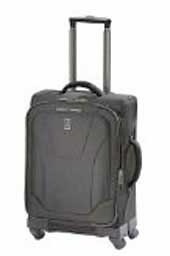 Travelpro Luggage Maxlite 2 20" Expandable Spinner
Travelpro Luggage Maxlite 2 20" Expandable Spinner
A shoulder bag for your daily walk-about.
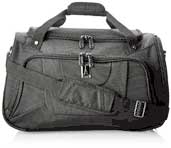 Travelpro Luggage Maxlite3 Soft Tote
Travelpro Luggage Maxlite3 Soft Tote
Keep your stuff organized.

Luggage Packing Cubes
eBags 3pc Set
The two gallon size is excellent for packing your clothes, but it is hard to find in Europe.
 Two gallon plastic bags
Two gallon plastic bagsZipLoc by SC Johnson
Inconspicuously lock your zippered luggage with a black wire tie.
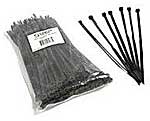 Cables to Go 43036 Cable Ties - 100 Pack (Black)
Cables to Go 43036 Cable Ties - 100 Pack (Black)
A Swiss Army Knife is unquestionably the handiest item a traveler can carry, except not on a plane.
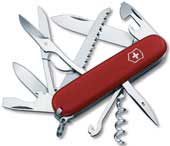 Victorinox Swiss Army Huntsman II Knife
Victorinox Swiss Army Huntsman II Knife
Note: The highlighted #E number is purely arbitrary. It is meant to help quickly identify products in this advert column when you write in for electrical advice.
See NOTE TO READERS.
Plug adapters are needed throughout Europe. There are at least five models used in different countries.
This adapter is for the standard grounded plug in France, Germany, and northern Europe. It does not fit in outlets of Italy, Switzerland, Ireland, and Britain.
#E-010
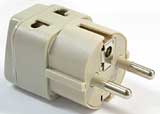 Grounded Universal 2 in 1 Plug Adapter
Grounded Universal 2 in 1 Plug Adapter
European Schuko plug.
4.8 mm prongs.
Equivalent to type E and F.
You can use this ungrounded Euro plug in some European countries.
#E-020
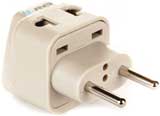 Universal 2 in 1 Plug Adapter
Universal 2 in 1 Plug Adapter
Euro Plug
4.0 mm prongs.
Equivalent to type C.
This is a universal plug adapter for the UK and Ireland.
#E-030
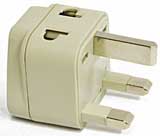 AC Adapter Plug for use in England, Scotland, Wales, and Ireland
AC Adapter Plug for use in England, Scotland, Wales, and Ireland
Equivalent to type G.
Here is the Swiss version.
#E-040
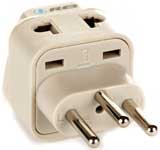 Grounded Universal 2 in 1 Plug Adapter
Grounded Universal 2 in 1 Plug Adapter
Type J for Switzerland
Here is the grounded Italian model.
#E-050
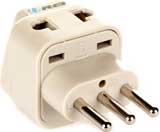 Grounded Universal 2 in 1 Plug Adapter
Grounded Universal 2 in 1 Plug Adapter
Type L for Italy
This 110-250 volt power surge strip has three universal outlets and an American grounded plug so it needs a plug adapter for the countries you are visiting. Make sure your gizmos are rated for 110-240 volts.
#E-060
 SM-60 Universal 3 Outlet Power Strip Surge Protector for Worldwide Travel. 110V-250V with Overload Protection.
SM-60 Universal 3 Outlet Power Strip Surge Protector for Worldwide Travel. 110V-250V with Overload Protection.
If your gizmos charge through a USB port this can keep you going. European cars have the same 12 volt system as American cars.
#E-200
 Scosche Dual USB
Scosche Dual USBCar Charger
The links in this pink field take you directly to a page at Amazon.com. The Amazon page details the item, and in most cases includes candid and critical comments from others who have bought the item.
Amazon pays my site a small commission when you click and order an item, if you put it in your shopping cart within 24 hours based on the cookie they set on your computer. If you don't want to make a quick decision just put it in your shopping cart, think it over, and come back later. The revenue covers the cost of maintaing this web site and keeps it free to users.
You benefit when buying here because Amazon has:
- 20% - 30% discount on many items,
- free shipping deals, direct to your door,
- no sales tax on internet purchases in most states,
- zillions of products, well almost,
- fast delivery even when it is free,
- shipment tracking in UPS, USPS, FedEx,
- easy returns if you are not happy with the product.
You win we win. Thanks for your support!!
Have a good trip in life,
John Bermont
Note: Italicized notations by the author.
This 50 watt 220/110 volt step down transformer is good for very small 110 volt appliances and light duty chargers.
#E-070
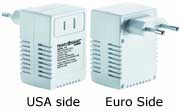 Travel Smart by Conair 50-Watt International Transformer
Travel Smart by Conair 50-Watt International Transformer
Wear a money belt under your shirt to protect your passport and valuables, especially if you are staying in hostels or dorms.
 Lewis N. Clark RFID Blocking Waist Stash
Lewis N. Clark RFID Blocking Waist Stash
An RFID blocking wallet protects your passport and credit cards from identity theft in public places.
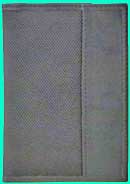 Travelon RFID Blocking Passport Case
Travelon RFID Blocking Passport Case
Inconspicuously lock your zippered luggage with a black wire tie.
 Cables to Go 43036 Cable Ties - 100 Pack (Black)
Cables to Go 43036 Cable Ties - 100 Pack (Black)
A Swiss Army Knife is unquestionably the handiest item a traveler can carry, except not on a plane.
 Victorinox Swiss Army Huntsman II Knife
Victorinox Swiss Army Huntsman II Knife
This will come in very handy very often.
 Fenix LD15
Fenix LD15High Performance
LED Flashlight
To help find your way on the winding and poorly posted roads of Europe. It works for civilian travelers also.
 Lensatic Military Marching Compass
Lensatic Military Marching Compass
This is my book, available at Amazon.com. The last edition was published in 2003. Critical up-dates are on this web site.
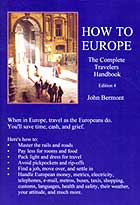 How To Europe
How To EuropeThe Complete
Travelers Handbook
by John Bermont
The best travel guide to all of Europe.
 Europe on a Shoestring
Europe on a ShoestringLonely Planet
A comprehensive guide to 3,000 hotels and restaurants in 44 major cities throughout Europe, in English. Separate books in the Michelin Red series cover individual countries in greater detail. This is a must have for frequent travelers.
 Main Cities of Europe 2015
Main Cities of Europe 2015Michelin Guide
Michelin will get you on the right road.
 Europe Map Michelin
Europe Map Michelin
This camera includes a GPS that automatically sets the internal clock depending on which time zone you are in.
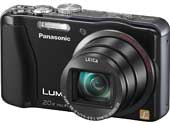 Panasonic Lumix ZS20 14.1 MP High Sensitivity MOS Digital Camera with 20x Optical Zoom
Panasonic Lumix ZS20 14.1 MP High Sensitivity MOS Digital Camera with 20x Optical Zoom
One of my favorite books. Ernest Hemingway in Paris.
 A Moveable Feast
by Ernest Hemingway
A Moveable Feast
by Ernest Hemingway
Rolling luggage sure beats lugging a pack on your back.
 Travelpro Luggage Maxlite 2 20" Expandable Spinner
Travelpro Luggage Maxlite 2 20" Expandable Spinner
A shoulder bag for your daily walk-about.
 Travelpro Luggage Maxlite3 Soft Tote
Travelpro Luggage Maxlite3 Soft Tote
Keep your stuff organized.

Luggage Packing Cubes
eBags 3pc Set
 Two gallon plastic bags
Two gallon plastic bagsZipLoc by SC Johnson
 Cables to Go 43036 Cable Ties - 100 Pack (Black)
Cables to Go 43036 Cable Ties - 100 Pack (Black)
 Victorinox Swiss Army Huntsman II Knife
Victorinox Swiss Army Huntsman II Knife
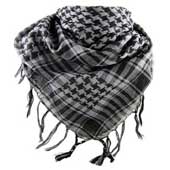 Very soft houndstooth neck scarf, Kanye West style, different colors available
Very soft houndstooth neck scarf, Kanye West style, different colors available

